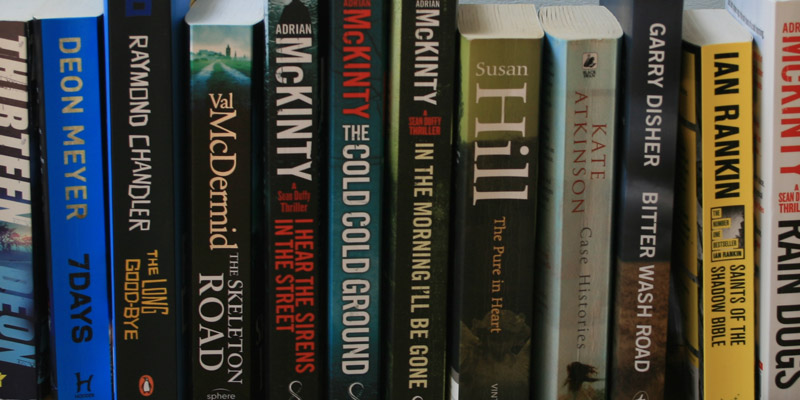
“The door was the first thing. The door was open. The front door was never open …”
Nicci French: The safe house
Why is the door open? What’s going on here? What’s going to happen next? After the first two and a half sentences of the book my imagination is already racing and I’m hooked.
I’ve always loved reading thrillers and crime fiction. So setting up a group to read crime stories in English was something that certainly appealed to me. But I didn’t do it for a long time because I had a few doubts about how well it would work. Would it really be an enjoyable experience for the members of the group? Or would having to read a set amount in preparation for each meeting become a chore – Oh no, I’ve got to read another 50 pages by tomorrow! Or perhaps frustrating if the story was really exciting, but you had to stop reading after a certain number of pages.
In 2010, I decided to just give it a go. At this point the main focus of my work had been on in-company Business English courses for over 10 years and I was ready for something completely different, for more variety.
The reading group started out with five friends and friends of friends. Naturally, over the last seven years people have left the group and new members have joined, but I’m very pleased to say that two of the original five are still there. 🙂
Not just whodunit
Part of the appeal of crime fiction is, of course, the excitement, wanting to know who committed the crime. That’s definitely a great motivation to carry on reading and a real advantage when you’re reading in a foreign language – which does take more effort than in your own language. But crime fiction offers so much more than that.
A trip to different places around the world
The very first book we read in the group was John Harvey’s Lonely Hearts – a police procedural centred around DI Charlie Resnick and set in Nottingham (very close to my hometown, Derby).
Since then we’ve travelled to Edinburgh, Dublin, Belfast, Cape Town, Los Angeles, the Australian outback, to name but a few. We’ve gained an impression of these places, their history, the way of life, how things are done there.
Sometimes reading a book has revived memories of past holidays spent there, sometimes it has inspired travel plans for the future.
All sorts of people
Then there’s the huge range of characters you get to know. On the one hand, there are the detectives who are usually described in great detail. How do they see the job? Are they team-players or loners? Do they have a private life? What sort of music do they listen to? What do they like to drink? Can be pretty inspiring, too 😉
And, on the other hand, there are the criminals. What is their history? What makes them tick? And their victims. Do they have a dark secret? Did they in some way attract the crime?
As you can imagine, there’s always plenty to talk about.
The richness of language
Besides vivid descriptions of places and people and exciting accounts of the action, it’s often the dialogues that contain the most interesting language. Everyday English as it is used in very different places by very different people.
As is the case whenever you read English books, you immerse yourself in the language, widen your vocabulary, learn new idioms, get a feeling for the language.
Over to you
If you’re now feeling motivated to read a crime story in English, here are some of the ones that went down best in the group.
Adrian McKinty – The cold cold ground, I hear the sirens in the street and In the morning I’ll be gone.
Three books from a series of novels with Sean Duffy – a vodka-gimlet-drinking Catholic policeman living on a Protestant street in Belfast in the 1980s. So at the height of the Troubles. The storylines are fast-moving and exciting. But it was the setting that left the greatest impression: everyday life in a city with constant violence, where everything can change from one minute to the next. And reading the books led us all to want to find out more about (Northern) Irish history and the background to the conflict.
Kate Atkinson – When will there be good news?
Kate Atkinson’s novels Life after life and A god in ruins are two of the best I’ve read in the last couple of years. Her characters are extremely finely drawn and you become engrossed in their lives. And that is exactly the same in the books with private investigator Jackson Brodie, my favourite of which is When will there be good news? I grew so fond of two of the characters – Joanna and Reggie – that I really didn’t want anything bad to happen to them. And that made the story all the more exciting.
P.D. James – The Lighthouse
This is a classic murder mystery by the queen of crime novels, the late P.D. James. It’s set on an island off the coast of Cornwall, which conveniently limits the number of suspects 😉 . The setting may be improbable, but that doesn’t matter at all. The interesting thing for us was getting to know each of the suspects and their past in detail as they are questioned by Commander Adam Dalgliesh of Scotland Yard, together with his inspector and sergeant. And trying to guess who the murderer was, of course.
What about you? Are there any crime stories you can recommend? If you’ve got any tips, I’d love to hear them.



